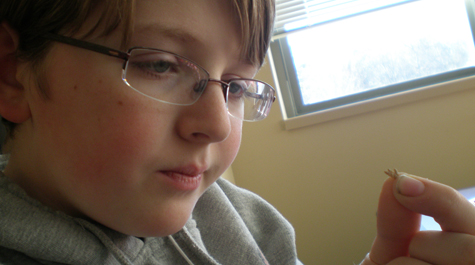Local sixth graders become 'citizen scientists' at W&M event
It may not be unusual to hear about children playing in dirt, but the sixth graders who gathered around piles of gray sediment in a William & Mary classroom recently weren’t playing. They were conducting research while also learning about careers in science, technology, engineering and mathematics (STEM).
Approximately 30 sixth graders from Williamsburg/James City County Schools participated in the STEM Education Alliance’s first RealScience Fest at W&M’s School of Education on Jan. 19. The participants spent the afternoon examining sediment taken from an excavation site in upstate New York where the remains of a mastodon were discovered in 2000.
The research is part of a nationwide effort by the Paleontological Research Institution called the Mastadon Matrix Project, which asks the public to act as “citizen scientists” and help examine the sediment – or “matrix” – from the excavation site.
The event was the latest in an ongoing series of efforts by W&M’s STEM Education Alliance to give K-12 students hands-on experience in the STEM fields, something organizers hope will lead to their knowledge of and interest in STEM careers.
“It would be cool if every kid in this room wanted to go into a STEM career, but we know they all won’t and that’s okay,” said Katie Green, project specialist with the STEM Education Alliance. “But for kids to go into a career that they are well-suited for makes us happy, and if it happens to be a STEM career, then, all the better.”
Hailey, a sixth grader with Berkeley Middle School, already has a STEM career in mind: engineering.
“Because I like building stuff and it’s fun,” she said.
As she used tweezers to carefully examine tiny clods of dirt on Saturday afternoon, she said that events like the RealScience Fest only further encourage her interest in the sciences.
She found Saturday’s task especially fun.
“I think it’s awesome because I get to look where an animal died, which is kind of sad, but still, it’s awesome,” she said. “I found a couple of shells, a few rocks, and a pine cone, which I thought was kind of cool -- a pine cone under water. It’s small. It was awesome.”
After carefully going through the sediment with tweezers and magnifying glasses, the participants separated their findings into categories including “animals,” “rocks” and “???”. With the help of STEM Education Alliance staff members and two graduate students from the School of Education, they weighed and recorded their findings.
The sediment and findings will soon be sent back to the Paleontological Research Institution to be included in the overall research on the site.
“We named it the RealScience Fest because it is real science as opposed to something that’s just pretend or simulated on a computer,” said Green. “This data will be published in a scientific journal.”
The STEM Education Alliance, which runs STEM programs with schools in conjunction with the Department of Defense and hosts summer events, hopes to host more events like this in the future, Green said.
“I’d love to be able to connect the things the students are doing to careers,” she said. “Some kids love to do research. Some kids love to do data collection. Some love to do the analysis. I think it’s neat for them to start finding out what they like to do so that they can choose a career that entails at least some things that they like to do.”
Megan Schoenberg, the mother of one of the participants and a scientist herself, said that things like the RealScience Fest are great opportunities for young students.
“I really think we have to do more with our kids to get them involved in STEM activities,” she said. “We’re way behind other countries. Our education system is fantastic, but our kids are not interested as much in STEM activities as they should be.”
Growing up, it was Star Wars that got her interested in the sciences, but she is glad to see things like the RealScience Fest do the same for today’s kids.
“The reality is that a lot of kids don’t know that they can do science, too,” she said. “They just have to learn.”






















